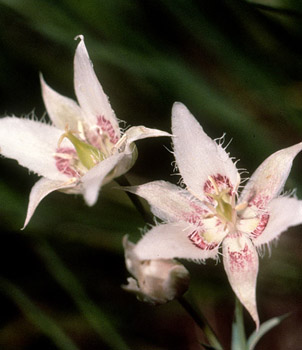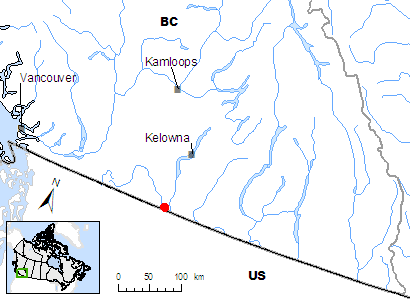
 Image Source: Left – Cannings, n.d. The Biodiversity of British Columbia. Right - Species at Risk, 2006. Lyall's Mariposa Lily Distribution.
Image Source: Left – Cannings, n.d. The Biodiversity of British Columbia. Right - Species at Risk, 2006. Lyall's Mariposa Lily Distribution.
To understand the basis for this project, it is important to outline background information relating to the mariposa lily. The information for this sections has been compiled from two different sources. Citations are provided at the end of each section and are detailed in the References section.
Appearance : Lyall’s mariposa lily is a long-lived perennial. It is a bulbous herb with long narrow leaves and soft-white flowers with purple crescent markings near the bottom of the petals. This type of lily flowers in June (Miller & Allen, 2001).
Distribution : The mariposa lily has been located in the Southern Okanagan in central British Columbia, down to Yakima County in Washington. The lily is also located along the Cascade Mountain's eastern front. In BC, the lily is currently limited to a small area of restricted land called “East Chopaka”, which divides the Okanagan and Similkameen Valleys. This small area is south of Richter Pass and west of Osoyoos, and is home to BC’s 11 known populations, all which occur 5 kilometers from each other (Miller & Douglas, 1999).
Habitat : This type of lily is found in natural grassy openings within Douglas-fir forests. It occurs at elevations ranging from 900m to 1300m, and is associated with well-drained, shallow soils (Miller & Allen, 2001). This type of lily is an endemic species, as it occurs only in the western Great Basin, an area which is hot and arid. These hot and arid regions contain various types of bunch grasses as well as open coniferous forests (Miller & Douglas, 1999).
Abundance : In British Columbia, this lily only has 11 known populations. Where these populations occur, the lily is very abundant, with some of the colonies having anywhere from 40 to half a million individual plants. These colonies range from 50 m squared to two hectares in size. These colonies are considered rare due to their lack of a viable dispersal mechanism (Miller & Douglas, 1999).
Threats and Sensitivities : The main threat to the current mariposa lily populations in BC is habitat destruction. This is associated with the grazing of livestock and deer, reforestation of surrounding clearings and competition from invasive species (Miller & Allen, 2001).
From this information, specific requirements and qualities of the mariposa lily's habitat have been chosen for this project. These include:
- Elevation (900 to 1300m)
- Aspect (Eastern front)
- Forest cover
- Rangeland, to represent grassy openings
- Protected areas located in the Southern Okanagan
- Biogeoclimatic zones of interior Douglas fir, ponderosa pine and bunch grass, to represent both temperature and precipitation. All of these zones are hot and arid.
- The current mariposa lily distributions
Along with these qualities, a specific region has been chosen to perform this analysis in. This area is the Southern Okanagan Basin ecosection. This ecosection was chosen due to the fact that the mariposa lily is currently found in the southern portion of this section. This ecosection represents an area with minor physiographic and microclimatic variations (ILMB Discovery Service, 2001).
